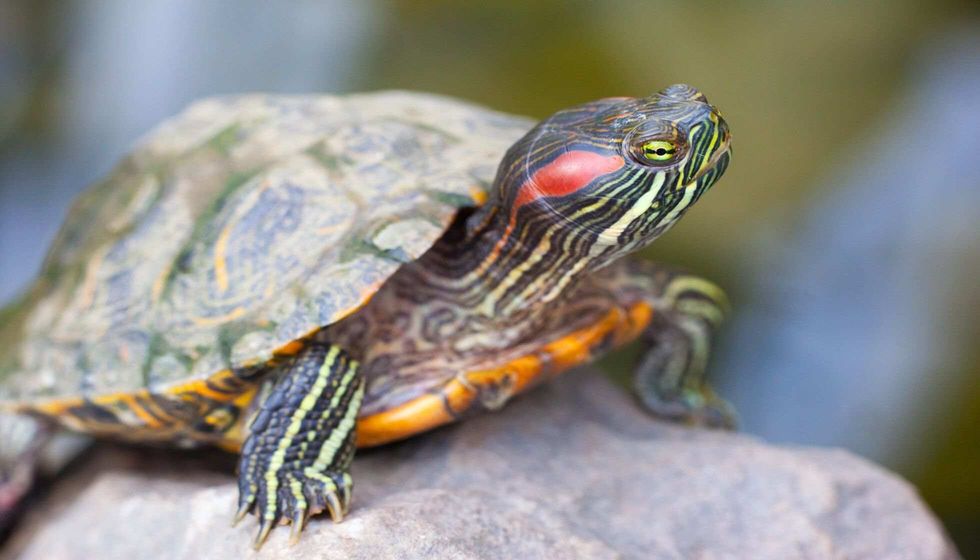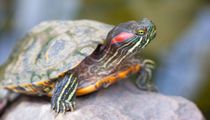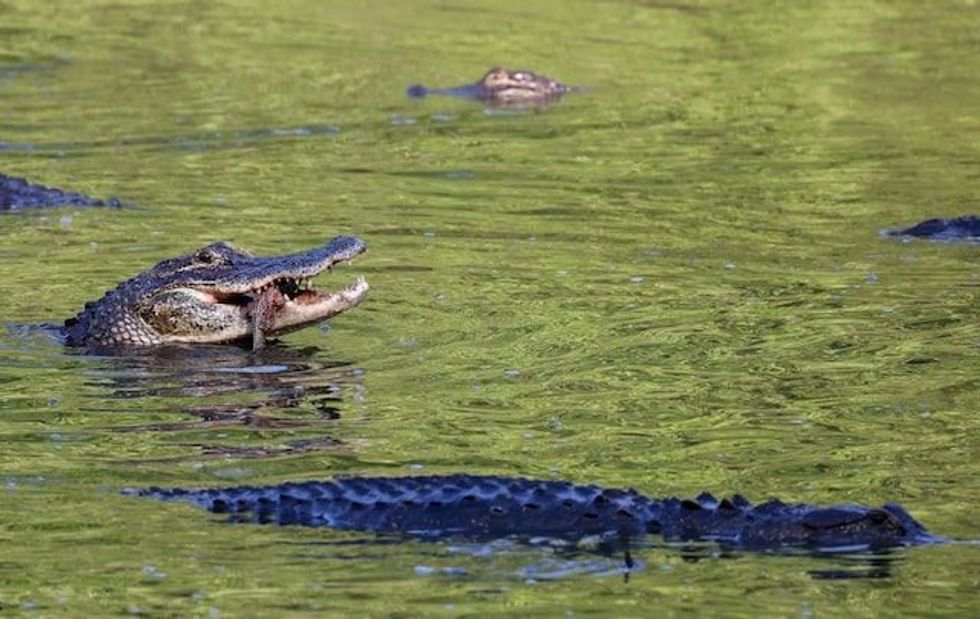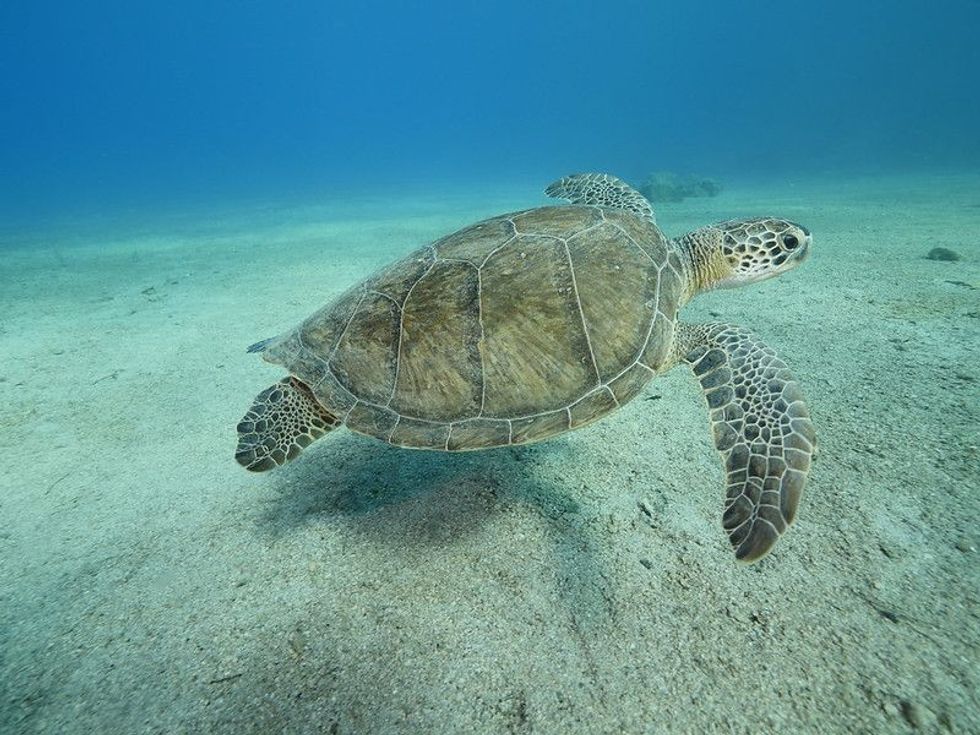Different Types Of Turtles: Guide To The Small And Cute Pet
When you hear the word 'turtle', then you might wonder if tortoises and turtles are the same species, but these two species are not the same.
Turtles are an aquatic reptile species known for their hard carapace and are one of the primitive species of animals in the world. Turtles are found globally and live in different climatic conditions.
The turtle species was first described by a German naturalist, August Johann Georg Karl Batsch, in 1788.
Turtles belong to the class of Reptilia, the clade of Perichelydia, and the order of Testudines. Turtles have three subgroups named Cryptodira, Pleurodira, and Paracryptodira.
The Cryptodira subgroup is known to have 11 families, 74 genera, and over 200 types of water turtles, whereas, the Pleurodira subgroup has three families, 16 genera, and over 60 species of turtles.
The Paracryptodira is an Extinct species of turtle subgroup which was known from the Jurassic to the Paleogene period in North America and Europe. Though most turtle species are omnivorous, the ones dwelling on land are herbivorous, while ones that inhabit the aquatic environment are carnivorous.
Freshwater turtles as well as sea turtles are known to produce certain low-level sounds such as grunting, blowing, and hooting in order to communicate with others of their own kind.
Turtles migrate from one place to another in order to find their partners or to lay eggs. Apart from this, climatic or seasonal changes make them a migratory aquatic type of species.
They have a wide range of geographical distribution and are found on almost every continent. Many sea turtles with small, inches-long limbs are on the Endangered list.
Because of this, CITES has banned and restricted the use of sea turtle products. There are different types of turtle species. Some like to live in freshwater and are called pond turtles, while others like to live in salty seawater, and thus, are called sea turtles.
You can even own a pet turtle and keep it in a large tank or pond near your house. Pet turtles might be slow pets, but you might love their calm and poised behavior.
If you enjoy reading this article about turtle species, then do read some interesting and surprising fun facts articles about different types of bulldogs and different types of tigers.
Facts About Turtles
Turtles are aquatic reptile animals that belong to the order of Testudines. Turtles are cold-blooded animals, and their body temperature varies according to climatic conditions.
Turtles spend their lives in the water such as in coastal areas of the sea. Mostly, they come on land either to lay eggs or rest in the sunshine. Turtles are known to have a lifespan of 30-100 years.
Turtles are basically divided into two groups: hidden-necked turtles and side-necked turtles. Turtles are found globally and are more prominently found in North America and south Asia. They can be found swimming deep in shallow bodies of water, feeding on small crustaceans, small fishes, mollusks, and snails, among other things.
Turtles are omnivorous and their main threats are humans, large aquatic animals such as sharks, raccoons, and large fish. There are 360 species of turtles.
In order to breathe air held in their lungs, they often come onto the land or up to the water surface. Generally, aquatic turtles are calm creatures, but if they are intruded upon while eating or mating, they may turn aggressive.
They are known for their cloacal respiration, which is a major source of respiration during their hibernation period. Different species of turtles can be kept as pets, and many frozen foods are available on the market to feed them.
How are turtles different from tortoises?
Turtles are very different from tortoises. A turtle and a tortoise may vary on the basis of their lifestyle, body structure, and eating habits. All tortoises can be turtles, but not all turtles are tortoises.
The simplest way in which you can differentiate between a tortoise and a turtle is on the basis of the places where they dwell. Turtles are aquatic animals that spend their time swimming in the water.
They can be seen on land in exceptional cases when they are either basking or wanting to lay eggs, whereas, the tortoise is a land reptile animal and spends most of its time on land.
In rare cases, a tortoise can be seen near or in water bodies such as during excessive heat. The head of an aquatic turtle goes partially inside its shell, whereas, the head of a tortoise goes completely inside its shell.
The tortoise species is mostly herbivorous, with an exception in a few cases. The turtle species is mostly omnivorous and feeds on both plants and aquatic animals such as small fish and shrimp.
A turtle has a flat, streamlined carapace or shell, whereas, a tortoise has a dome-shaped carapace with bumps in a few of the species. The shell of the tortoise is heavier and harder in comparison to that of the turtle species.
An aquatic turtle has webbed feet with long claws, while the tortoise has bent legs with short feet. Hatchlings of tortoises are known to shift to their mother's burrows, whereas, hatchlings of turtles are independent and live on their own once they hatch out of eggs.
A tortoise can live for many years, up to 150 years and the turtle is known to survive for a maximum of 100 years.
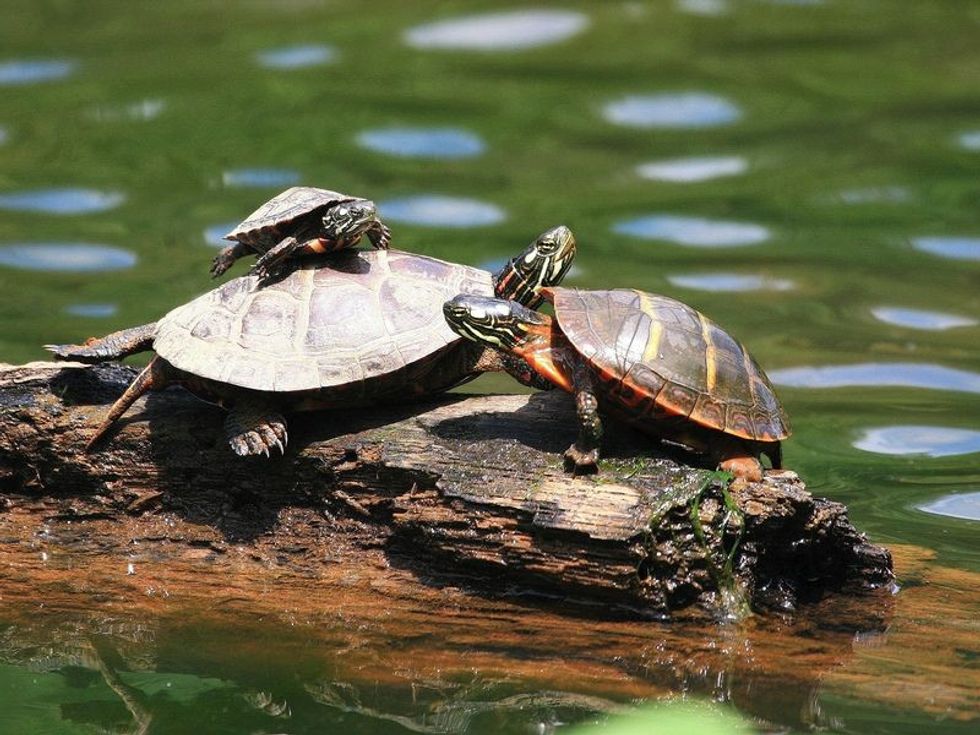
List Of Other Turtle Species
There are different types of sea turtles found globally. A few of them are kept as pets, such as the wood turtle, the eastern box turtle, the western painted turtle, the northern red-bellied cooter, and the red-eared slider. Some species of aquatic turtles are Endangered, such as the diamondback terrapin and the bog turtle.
The Mississippi map turtle is named after the Mississippi River. These turtles are listed as Least Concern by the IUCN.
Mississippi map turtles are a type of turtle species with a unique dorsal fin along with its carapace. Mississippi map turtles have a geometric pattern on their bodies with a yellow line on a mud brown background, which is their skin color. Females are a few inches longer in comparison to males of the species.
Eastern mud turtles, or common mud turtles, belong to the family of Kinosternidae. This species is not Endangered and is on the IUCN's list of species as Least Concern.
In eastern America, these mud turtles are common and popular in the pet trade. The male is a few inches longer than the female of the species. Males have rough scale patches.
The yellow-spotted turtle should be fed leafy greens along with fresh meat. The yellow-spotted turtle is a threatened species and is on the list as Endangered by the IUCN.
The yellow-spotted turtle is named after yellow spots on its carapace, unlike the yellow-bellied turtle, which has a yellow underbelly. The yellow-bellied slider is diurnal and should be kept in a large tank.
Snapping turtles are also common among pet turtle species and are good for the ecosystem. The snapping turtle often acts like a scavenger, which helps to remove dead and decayed organisms in water bodies.
At the same time, a snapping turtle can destroy a water body's habitat due to its eating habits. The adult snapping turtle needs more care than its hatchlings. The bog turtle is a semiaquatic turtle found only in endemic eastern America.
The bog turtle is a Critically Endangered species of turtle and is a diurnal reptile. They are secretive and can mostly be seen in their sand burrows.
Apart from them, threatened and Endangered species of turtles need to be preserved. The diamondback terrapin, scientific name Malaclemys terrapin, is a threatened species and is listed as Vulnerable by the IUCN.
They are a native species living in brackish water near the Atlantic and Gulf coastal regions of America. Reproduction takes place in early spring, and in a clutch, around 4-22 eggs are laid.
A wood turtle would be good as a pet, but unfortunately keeping it as a pet is not advised because this species is threatened and is on the list of Endangered by the IUCN. The wood turtle is endemic to North America.
Males are a few inches longer than female wood turtles. The wood turtle is oviparous and can move at a speed of 0.2 mph (0.32 kph). The Convention on International Trade in Endangered Species (CITES) has banned and restricted the use of sea turtle products.
The aquatic list of turtle species includes mud turtles, musk turtles from the family of Kinosternidae, pitted shell turtles from the family of Carettochelys insculpta, and pond turtles from the family of Emydidae and Bataguridae. The Emydidae family consists of the Blanding's turtle, the chicken turtle, the painted turtle, and the terrapin.
Sea turtles are from the families of Dermochelyidae and Cheloniidae. Side-necked turtles are from the families of Chelidae, Pelomedusidae, and Podocnemididae.
The Arrau is a species of the same family. Other aquatic turtles include snake-necked turtles from the family of Chelidae, snapping turtles from the family of Chelydridae, and softshell turtles from the family of Trionychidae.
When it comes to terrestrial turtles, Asian box turtles from the family of Geomydidae, and tortoises from the family of Testudinae, come into play. Spotted turtles and wood turtles from the family of Emydidae and genus Clemmys are also terrestrial turtles, along with North American box turtles from the genus Terrapene.
They belong to the same family, Emydidae. In Australia, long-necked turtles named eastern long-necked turtles and short-necked turtles named Murray River turtles can be kept as pets.
What are the best turtles for pets?
The best pet turtle species are the red-eared slider turtle, the African side-necked turtle, the eastern box turtle, the western painted turtle, the Mississippi map turtle, the common musk turtle, the spotted turtle, the yellow-bellied slider turtle, the reeve's turtle Chinese pond turtle, and the wood turtle.
Your pet turtle should be provided with leafy greens and fresh meat, along with a clean, freshwater tank.
The common musk turtle, scientific name Sternotherus odoratus, is a well-known pet turtle species that is well known for its musty and foul-smelling releases that occur when it senses danger nearby. Common musk turtles require less care and are a small-sized turtle species.
The stinkpot turtle and the eastern musk turtle are other names for the common musk turtle.
When it comes to swimming, these musk turtles are not good at swimming and should not be kept in shallow water regions. Common musk turtles can live for up to 50 years.
The red-eared slider turtle, scientific name Trachemys scripta elegans, is also called the water slider turtle. The red-eared slider can live 2-30 years.
The red-eared turtle is good at socializing and is also an active turtle species. When a red-eared turtle is small, it can be kept inside the house, but when it grows into an adult, it must be kept in its natural habit, a nearby pond.
The family that the red-eared slider turtle belongs to is Emydidae, a suborder of Cryptodira.
The red-eared slider enjoys living in warmer places or environments. A red-eared slider has red stripes near its ears hence its name.
The African side-necked turtle is different from other turtles and needs a lot of care. These side-necked turtles, whose scientific name is Pelomedusa subrufa, should be fed fresh food in order to avoid any deficiency in vitamin D3 and vitamin A.
They need a proper basking place where they can rest and take in the sun's UV rays.
Due to their long necks, they have to first bend their neck to the side and then their neck goes into the shell but only partially. They are the preferred turtle species in the turtle pet trade.
The eastern box turtle, scientific name Terrapene carolina carolina, is also called a land turtle. In captivity, the eastern box turtle can live up to the age of 40 years, while in the wild it can thrive for up to 100 years.
These turtles live in moist and humid climatic conditions. As a pet they should be kept in a deep water tank or pond. The eastern box turtle belongs to the Emydidae family, which is classified as Vulnerable by the IUCN.
The western painted turtle, scientific name Chrysemys picta bellii, can survive up to 50 years. The western painted turtle needs the same care as the red-eared slider.
A clean and large tank with freshwater is needed for these pet turtles. The western painted turtle with yellow stripes on its body is a beautiful species. The western painted turtle is not Endangered and is on the IUCN's list as Least Concern.
Here at Kidadl, we have carefully created lots of interesting family-friendly facts for everyone to enjoy! If you liked our suggestions for different types of turtles, then why not take a look at different types of
We Want Your Photos!
More for You
Bachelor of Arts specializing in English, Bachelor of Education specializing in Secondary Education and Teaching, Master of Arts specializing in English

Anamika BalouriaBachelor of Arts specializing in English, Bachelor of Education specializing in Secondary Education and Teaching, Master of Arts specializing in English
Bachelor of Commerce specializing in Marketing and HR

Pradhanya RaoBachelor of Commerce specializing in Marketing and HR
With a Bachelor’s degree in Commerce from Christ University, Bangalore, Pradhanya's passion for the English language and literature led her to explore the field of content writing, where she has gained extensive experience in writing, reviewing, editing, and fact-checking. She has also earned certifications in Google Ads Search, Google Ads Display, and Social Media Marketing, showcasing her proficiency in digital marketing.
Disclaimer
1) Kidadl is independent and to make our service free to you the reader we are supported by advertising. We hope you love our recommendations for products and services! What we suggest is selected independently by the Kidadl team. If you purchase using the Buy Now button we may earn a small commission. This does not influence our choices. Prices are correct and items are available at the time the article was published but we cannot guarantee that on the time of reading. Please note that Kidadl is a participant in the Amazon Services LLC Associates Program, an affiliate advertising program designed to provide a means for sites to earn advertising fees by advertising and linking to Amazon. We also link to other websites, but are not responsible for their content.
2) At Kidadl, we strive to recommend the very best activities and events. We will always aim to give you accurate information at the date of publication - however, information does change, so it’s important you do your own research, double-check and make the decision that is right for your family. We recognise that not all activities and ideas are appropriate for all children and families or in all circumstances. Our recommended activities are based on age but these are a guide. We recommend that these ideas are used as inspiration, that ideas are undertaken with appropriate adult supervision, and that each adult uses their own discretion and knowledge of their children to consider the safety and suitability. Kidadl cannot accept liability for the execution of these ideas, and parental supervision is advised at all times, as safety is paramount. Anyone using the information provided by Kidadl does so at their own risk and we can not accept liability if things go wrong.
3) Because we are an educational resource, we have quotes and facts about a range of historical and modern figures. We do not endorse the actions of or rhetoric of all the people included in these collections, but we think they are important for growing minds to learn about under the guidance of parents or guardians.
